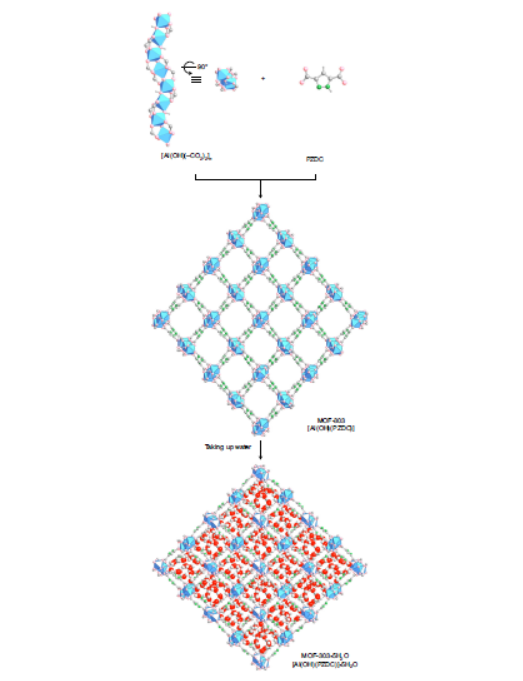Home >
News > Green Scalable Synthesis of MOF-303 for Desert Water Harvesting
Green Scalable Synthesis of MOF-303 for Desert Water Harvesting
Summary:
The authors from the Department of Chemistry, University of California, Berkeley, Kavli Energy Nanoscience Institute, University of California, Berkeley, and Bakar Institute of Digital Materials for the Planet, University of California, Berkeley (USA) developed MOF-303 (Al(OH)(PZDC), PZDC = 1-H-pyrazole-3,5-dicarboxylate) with high water stability, low relative humidity water uptake, mild heating water release, and green scalable synthesis characteristics, achieving high-yield (up to 94%) kilogram-scale (3.5 kg per batch) production and excellent water harvesting performance from desert air.

Background:
1. To address global water scarcity—with the United Nations projecting nearly five billion people will face water stress by 2050, and direct atmospheric water harvesting being energy-consuming (especially at low relative humidity, RH)—previous researchers developed sorbent-assisted water-harvesting systems. However, most work on suitable metal–organic framework (MOF) sorbents was limited to milligram/gram scale, with few reports on kilogram-scale synthesis for water harvesting.
2. The authors proposed four green, water-based synthetic methods (solvothermal, reflux, vessel, microwave) for MOF-303, optimizing the NaOH:H₂PZDC molar ratio to 3:1 to boost yield from 38% to 94%, and realizing kilogram-scale production with retained crystallinity and water uptake capacity.
Research Content:
1. Synthesis
The authors synthesized MOF-303 using four water-based methods:
-Solvothermal method: Reacted in a glass bottle at 120 °C for ~24 h, 100 mL scale, 38% yield, 0.74 g dry MOF per batch.
-Reflux method: Refluxed at 120 °C for 2 h (total time <6 h), 100 mL scale, 94% yield, 1.87 g dry MOF per batch.
-Vessel method: Used 20–200 L vessels with reflux, 60,000 mL scale, 91% yield, 3590 g (3.5 kg) dry MOF per batch.
-Microwave method: Heated by microwave at 120 °C for only 5 min, 15 mL scale, 92% yield, 0.54 g dry MOF per batch. All methods used AlCl₃·6H₂O, H₂PZDC·H₂O, NaOH, and deionized water as raw materials.
2. Characterizations
1.BET and pore size distribution: All MOF-303 samples had comparable Brunauer–Emmett–Teller (BET) specific surface areas >1300 m²/g (reflux: 1384 m²/g; vessel: 1380 m²/g; microwave: 1307 m²/g) via nitrogen sorption isotherms at 77 K.
2.SEM tests: SEM images showed cubic-shaped particles with narrow size distribution per method: solvothermal (100–500 nm), reflux (300–500 nm), vessel (400–900 nm), microwave (50–200 nm).
3.Other tests:
-PXRD: Confirmed high crystallinity of MOF-303.
-Water isotherms: At 25 °C, S-shaped profile, 39 wt% water uptake at 20% RH, inflection point ~12% RH.
-TGA: Stable up to 400 °C; solvent (water/ethanol) fully removed at 120 °C.
-Digest-¹H-NMR: Single singlet peak at 6.7 ppm (pyrazole dicarboxylate linker), indicating high purity and no residual ethanol.
-Elemental analysis: C (~29.77–29.88%), H (~1.53–1.58%), N (~13.27–13.44%), consistent with calculated values (C:30.32%, H:1.53%, N:14.15%), confirming no impurities.
3. Application
The material was tested for water harvesting from desert air. MOF-303 showed efficient water uptake at low RH (39 wt% at 20% RH) and water release under mild heating. The vessel method’s 3.5 kg batch product had similar crystallinity and water uptake to small-scale samples, supporting potential commercial application in household water-harvesting devices.
4. Mechanism
-Synthesis mechanism: Optimizing NaOH:H₂PZDC to 3:1 ensured full deprotonation of H₂PZDC, enhancing solubility and reaction with Al³⁺ to form MOF-303’s 1D infinite rod-like secondary building units (SBUs) connected by PZDC linkers (xhh topology), improving yield and crystallinity.
-Water harvesting mechanism: MOF-303’s intrinsic porosity and hydrophilic sites enable water adsorption at low RH; mild heating (≥120 °C) removes adsorbed water by breaking water–framework interactions, realizing cyclic water capture and release.
-Hysteresis mechanism: Minor hysteresis in water isotherms is attributed to lattice defects; microwave/vessel method’s high-RH steep uptake comes from interparticle condensation (small crystal aggregation forming interparticle cavities).

Outlook:
This research realizes green, scalable (gram to kilogram) synthesis of MOF-303 with four flexible methods, solving the scale-up bottleneck of water-harvesting MOFs. The material’s excellent low-RH water uptake and mild release performance provides a feasible solution for desert air water harvesting, laying a foundation for commercialization to alleviate global water scarcity.
High-yield, green and scalable methods for producing MOF-303 for water harvesting from desert air
Authors: Zhiling Zheng, Ha L. Nguyen, Nikita Hanikel, Kelvin Kam-Yun Li, Zihui Zhou, Tianqiong Ma, Omar M. Yaghi
DOI: 10.1038/s41596-022-00756-w
Link: https://www.nature.com/articles/s41596-022-00756-w
The above review is for academic progress sharing. For any errors or copyright issues, please contact us for correction or removal.

